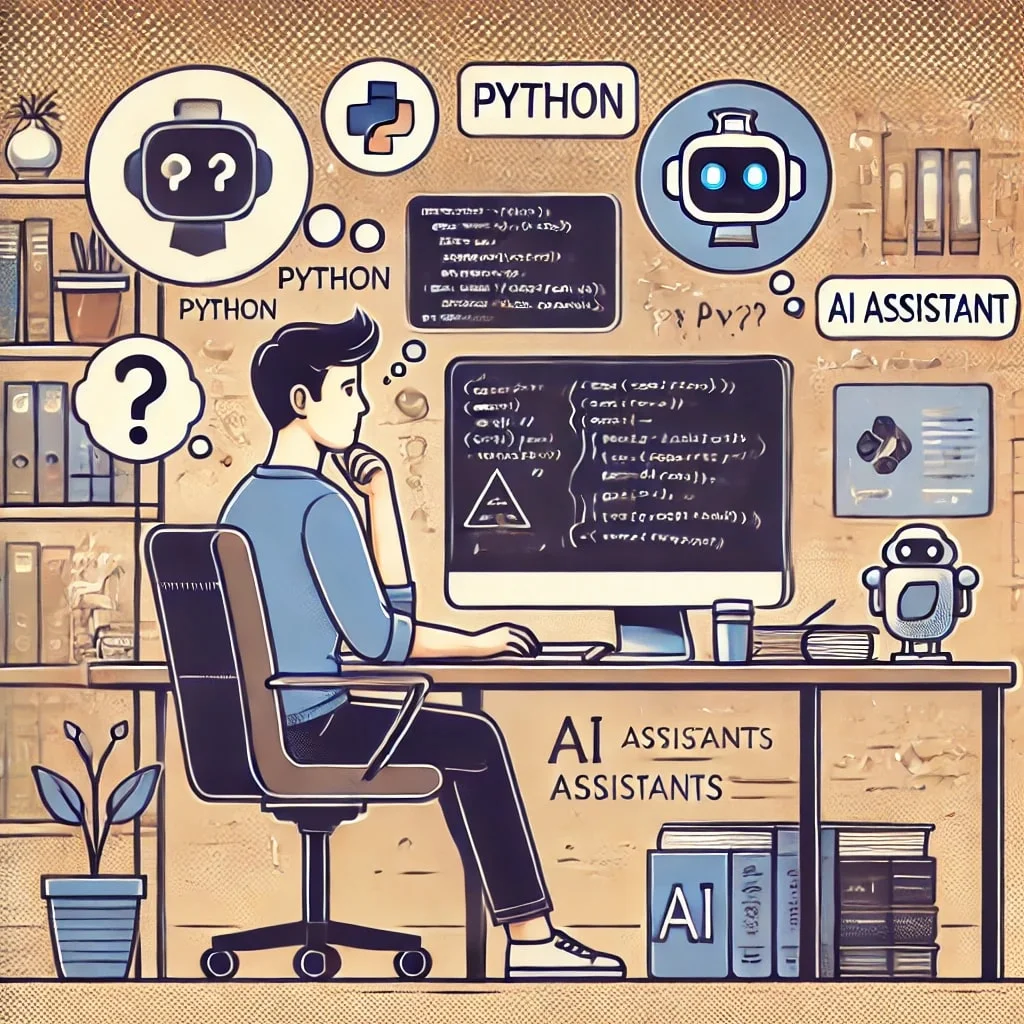Table of Contents
- Understanding AI Assistants
- What Makes an AI Assistant "Intelligent"?
- Prerequisites and Foundation
- Essential Libraries:
- Step-by-Step Development Guide
- Setting Up Your Development Environment
- Building the Core NLP Engine
- Implementing Machine Learning Models
- Creating the Response Generation System
- Advanced Features and Customization
- Context Memory
- Emotional Intelligence
- Testing and Deployment
- Unit Testing
- Integration Testing
- Ethical Considerations
- Data Privacy
- Bias Prevention
- Transparency
- User Consent
- Responsible AI Development
- Future-Proofing Your AI Assistant
- Regular Model Updates
- Performance Metrics Monitoring
- User Feedback Collection
- AI Research Updates
- Training Data Improvement
- Embark on Your AI Development Journey
- Additional Resources
Article Summary Powered OpenAI
Margabagus.com – Are you fascinated by the potential of artificial intelligence but unsure where to start in creating your own AI assistant? You’re not alone. As someone who has spent years working with AI technologies, I’m excited to guide you through the process of developing your personal AI assistant from scratch.
Understanding AI Assistants
When we talk about AI assistants, we’re referring to software programs that can understand, process, and respond to human input in natural language. According to Dr. Andrew Ng, founder of DeepLearning.AI and former head of Google Brain, “AI is the new electricity” – it’s transforming every industry and becoming an essential part of our daily lives.
What Makes an AI Assistant “Intelligent”?

Photo by Innovalabs on Pixabay
At its core, an AI assistant combines several key technologies:
- Natural Language Processing (NLP)
- Machine Learning algorithms
- Knowledge base management
- Context understanding
- Response generation
Dr. Emily Bender, a computational linguistics professor at the University of Washington, emphasizes that “effective AI assistants aren’t just about processing language; they’re about understanding context and providing meaningful responses.”
Get the Latest Article Updates via WhatsApp
Prerequisites and Foundation
Before we dive into development, let’s ensure you have the necessary tools and knowledge:
- Python 3.8 or higher
- Basic understanding of programming concepts
- Familiarity with machine learning fundamentals
- Development environment (VS Code, PyCharm, or similar)
- GPU access (recommended for training)
Essential Libraries:
import tensorflow as tf import transformers import nltk import spacy import pytorchCheck out this fascinating article: Claude AI vs ChatGPT vs Gemini: Ultimate Battle 2025
Step-by-Step Development Guide

Photo by Christina Morillo on Pexels
1. Setting Up Your Development Environment
First, let’s create a robust development environment. According to Dr. Rachel Thomas, co-founder of fast.ai, “A well-structured environment is crucial for successful AI development.”
# Create a virtual environment python -m venv ai-assistant source ai-assistant/bin/activate # On Windows: ai-assistant\Scripts\activate # Install required packages pip install tensorflow transformers nltk spacy pytorch2. Building the Core NLP Engine
The heart of your AI assistant is its ability to understand natural language. Dr. Christopher Manning, Director of the Stanford AI Lab, suggests starting with a basic but solid NLP foundation:
def preprocess_text(input_text): # Remove unnecessary whitespace text = ' '.join(input_text.split()) # Convert to lowercase text = text.lower() # Tokenization tokens = nltk.word_tokenize(text) return tokens def understand_intent(tokens): # Basic intent classification intents = { 'greeting': ['hello', 'hi', 'hey'], 'farewell': ['goodbye', 'bye', 'see you'], 'query': ['what', 'how', 'why', 'when', 'where'] } for intent, keywords in intents.items(): if any(word in tokens for word in keywords): return intent return 'general'3. Implementing Machine Learning Models
Now, let’s incorporate machine learning capabilities. According to Dr. Yann LeCun, Chief AI Scientist at Meta, “The key to building effective AI systems is choosing the right architecture for your specific use case.”
from transformers import AutoModelForSequenceClassification, AutoTokenizer def initialize_model(): # Load pre-trained model and tokenizer model_name = "bert-base-uncased" tokenizer = AutoTokenizer.from_pretrained(model_name) model = AutoModelForSequenceClassification.from_pretrained(model_name) return model, tokenizer def process_user_input(text, model, tokenizer): # Tokenize input inputs = tokenizer(text, return_tensors="pt", padding=True, truncation=True) # Get model outputs outputs = model(**inputs) return outputsCheck out this fascinating article: AI SEO Optimization: How to Maximize Search Engines
4. Creating the Response Generation System
Your AI assistant needs to generate relevant and coherent responses. Dr. Kathleen McKeown, founding director of the Data Science Institute at Columbia University, recommends implementing a hybrid approach:
def generate_response(intent, context, model_output): responses = { 'greeting': ['Hello! How can I help you today?', 'Hi there! What can I do for you?'], 'farewell': ['Goodbye! Have a great day!', 'See you later! Take care!'], 'query': ['Let me help you with that.', 'I'll find that information for you.'] } # Use context and model output to generate appropriate response if intent in responses: return random.choice(responses[intent]) else: return "I'm processing your request. Could you please provide more details?"Advanced Features and Customization
To make your AI assistant truly unique, consider implementing these advanced features:
1. Context Memory
class ConversationMemory: def __init__(self): self.memory = [] self.max_memory = 10 def add_to_memory(self, user_input, assistant_response): self.memory.append({ 'user_input': user_input, 'response': assistant_response, 'timestamp': datetime.now() }) if len(self.memory) > self.max_memory: self.memory.pop(0)2. Emotional Intelligence
Dr. Rosalind Picard, founder and director of the Affective Computing Research Group at MIT, emphasizes the importance of emotional intelligence in AI assistants:
def analyze_sentiment(text): from textblob import TextBlob analysis = TextBlob(text) # Get polarity score (-1 to 1) sentiment_score = analysis.sentiment.polarity # Adjust response based on sentiment if sentiment_score < -0.3: return "I sense you're frustrated. Let me try to help." elif sentiment_score > 0.3: return "I'm glad you're excited! Let's continue." else: return NoneTesting and Deployment

Photo by Christina Morillo on Pexels
1. Unit Testing
Always implement comprehensive testing:
import unittest class TestAIAssistant(unittest.TestCase): def setUp(self): self.assistant = AIAssistant() def test_response_generation(self): response = self.assistant.generate_response("greeting", {}, None) self.assertIsNotNone(response) self.assertIsInstance(response, str)2. Integration Testing
Dr. Margaret Mitchell, former AI ethics researcher at Google, recommends thorough integration testing:
def test_full_conversation_flow(): assistant = AIAssistant() # Test basic conversation flow greeting = assistant.process_input("Hello!") assert greeting.startswith("Hi") or greeting.startswith("Hello") # Test context retention follow_up = assistant.process_input("What can you help me with?") assert len(follow_up) > 0Ethical Considerations
As AI developers, we have a responsibility to create ethical and unbiased systems. Dr. Timnit Gebru, founder of DAIR, emphasizes the importance of:
Data Privacy
When developing AI assistants, protecting user data is paramount. Implement these essential measures:
- End-to-end encryption for all user conversations
- Regular data anonymization processes
- Secure storage protocols with automated deletion policies
- Clear data retention policies
- Compliance with GDPR, CCPA, and other relevant privacy regulations
As Dr. Helen Nissenbaum, Professor of Information Science at Cornell Tech, notes: “Privacy isn’t just about hiding; it’s about maintaining appropriate flows of information in different contexts.”
Check out this fascinating article: AI SEO Optimization: How to Maximize Search Engines
Bias Prevention
AI systems can inadvertently perpetuate or amplify existing biases. To prevent this:
- Use diverse training data sets
- Regularly audit your AI’s responses for potential biases
- Implement fairness metrics in your evaluation process
- Create diverse development teams
- Test your system across different demographic groups
Dr. Joy Buolamwini, founder of the Algorithmic Justice League, emphasizes: “We need to ensure that AI systems work for everyone, not just a privileged few.”
Transparency
Build trust by being open about your AI assistant’s capabilities and limitations:
- Clearly communicate when users are interacting with AI
- Provide explanations for AI decisions when possible
- Document your AI’s training process and data sources
- Make your AI’s limitations explicit to users
- Maintain an accessible audit trail of system changes
User Consent
Implement robust consent mechanisms:
- Obtain explicit permission before collecting user data
- Provide clear opt-in/opt-out options
- Explain how user data will be used
- Allow users to access and delete their data
- Regular consent renewal prompts for long-term users
Responsible AI Development
Follow these principles for ethical AI development:
- Regular ethical impact assessments
- Establishment of an AI ethics board
- Clear guidelines for handling sensitive information
- Emergency shutdown protocols
- Regular consultation with ethics experts and affected communities
Future-Proofing Your AI Assistant

Photo by tungnguyen0905 on Pixabay
To ensure your AI assistant remains relevant and effective:
Regular Model Updates
Keeping your AI assistant current is crucial for maintaining its effectiveness:
- Schedule monthly model evaluations
- Implement automated update pipelines
- Test new model versions in staging environments
- Maintain version control for all model changes
- Document performance improvements with each update
Dr. Yoshua Bengio, Scientific Director at Mila, advises: “Regular updates aren’t just about fixing bugs—they’re about evolving your AI to meet changing user needs.”
Performance Metrics Monitoring
Establish comprehensive monitoring systems:
- Track response accuracy and relevance
- Measure response time and system latency
- Monitor resource usage and optimization
- Analyze user satisfaction metrics
- Implement automated alerting systems for issues
Set up dashboards to track key metrics:
def monitor_performance(): metrics = { 'response_time': [], 'accuracy_score': [], 'user_satisfaction': [], 'error_rate': [], 'resource_usage': [] } return generate_performance_report(metrics)User Feedback Collection
Implement systematic feedback collection:
- In-conversation feedback options
- Regular user surveys
- A/B testing for new features
- User behavior analytics
- Direct user interviews
Create feedback loops:
class FeedbackSystem: def collect_feedback(self, interaction): feedback = { 'user_rating': interaction.rating, 'completion_rate': interaction.completed, 'time_to_resolution': interaction.duration, 'follow_up_questions': interaction.follow_ups } return self.analyze_feedback(feedback)AI Research Updates
Stay current with the latest developments:
- Subscribe to leading AI research journals
- Participate in AI conferences and workshops
- Join AI research communities
- Follow key AI researchers on academic platforms
- Collaborate with research institutions
Dr. Sebastian Thrun, founder of Udacity, suggests: “The field of AI moves so quickly that staying updated isn’t optional—it’s essential for survival.”
Training Data Improvement
Continuously enhance your training data:
- Regular data quality audits
- Implementation of active learning techniques
- Data augmentation strategies
- User interaction data incorporation
- Regular cleanup of outdated data
Example implementation:
class DataEnhancement: def improve_training_data(self, existing_data, new_interactions): # Filter high-quality interactions quality_interactions = self.filter_quality_data(new_interactions) # Augment existing dataset enhanced_dataset = self.augment_data(existing_data, quality_interactions) # Validate enhanced dataset if self.validate_dataset(enhanced_dataset): return enhanced_dataset return existing_dataEmbark on Your AI Development Journey
The world of AI development is more accessible than ever before. As you’ve seen throughout this guide, creating your own AI assistant isn’t just about writing code—it’s about crafting an intelligent companion that can transform how we interact with technology. Dr. Fei-Fei Li beautifully captures this vision: “AI should be about augmenting human intelligence, not replacing it.”
Your journey into AI development is like planting a seed that will grow into something extraordinary. With each line of code you write and every feature you implement, you’re not just building an assistant—you’re contributing to the future of human-AI interaction. The skills and knowledge you’ve gained here are just the beginning.
Remember, every expert in AI started exactly where you are now. The difference between dreaming about creating an AI assistant and actually building one comes down to taking that first step. You’ve already taken it by reading this guide, and now you have the blueprint to turn your vision into reality.
As you move forward, embrace the challenges, celebrate the small victories, and never stop experimenting. Your unique perspective and creativity could lead to innovations that push the boundaries of what’s possible with AI assistants.
The future of AI is not just in the hands of large tech companies—it’s in your hands too. So, what groundbreaking AI assistant will you build next?
Take that knowledge, start coding, and create something amazing. The world is waiting to see what you’ll develop.
Additional Resources
For further learning, I recommend:
- Fast.ai’s Practical Deep Learning Course
- Stanford’s CS224N: Natural Language Processing with Deep Learning
- DeepLearning.AI’s specialization courses
- “Artificial Intelligence: A Modern Approach” by Stuart Russell and Peter Norvig
Remember, the field of AI is constantly evolving, so stay curious and keep learning!




